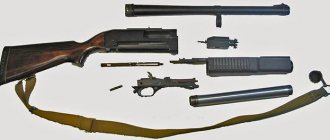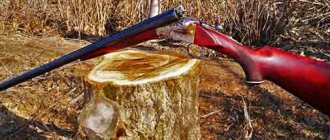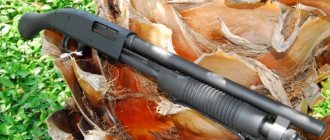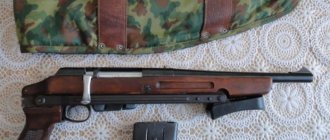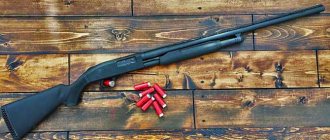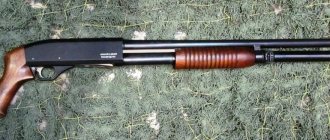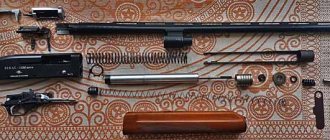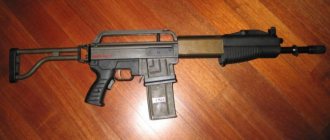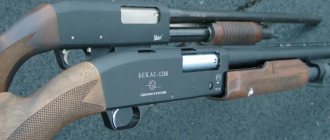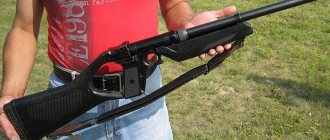RMB-93 is a smooth-bore combat shotgun with a pump-action reloading mechanism, developed by TsKIB SOO in 1993 and intended for use by special units of law enforcement agencies of the Russian Federation. The abbreviation RMB stands for repeating combat rifle, but with the number 93 everything is clear, this is the year of manufacture. Subsequently, based on the military model RMB-93, the RMO-93 Lynx gun, intended for hunting, was released. The civilian hunting rifle has a large number of modifications that were developed to allow each hunter to choose the necessary equipment.
It is worth noting that the RMB-93 pump-action shotgun has a somewhat non-standard reloading scheme applicable to pump-action shotguns; it is reloaded by moving the fore-end along with the barrel. This design measure, in contrast to a sliding bolt, helps to significantly reduce the weight of the gun, reduce its dimensions and increase the magazine capacity.
History of creation
The Lynx pump-action shotgun is considered a relatively new model, the development of which was carried out by gunsmiths from TsKIB (Central Design Research Bureau) of the city of Tula. Everyone knows that smooth-bore weapons of the Lynx brand manufactured by TsKIB were famous at that time for their quality. For this reason, it was his specialists who were entrusted with the development of weapons for the law enforcement agencies of our country. It should be noted that this refers to Lynx brand pump-action shotguns.
At that time in Russia, smoothbore guns were almost never used in special forces, and the sample from TsKIB was a good and very original model of the RMB-93 gun, known as the “Lynx”. Initially, the design intended a combat purpose for special forces units, which determined the specificity and narrow use of the new pump-action shotgun. The Lynx brand gun was not planned for release on the civilian market.
Unfortunately, the heads of law enforcement agencies did not like the unusual and unusual operation of the mechanisms and the very design of the RMB-93, and they abandoned the pump-action shotgun. But as a result of some work, a new model of a full-fledged smoothbore gun was obtained, which was sent “to the people” with a changed name and certain modifications.
If the model was originally called RMB-93, then in the civilian version it sounded like RMO-93, where the third letter determined the main purpose - hunting.
Links[edit]
- https://weapon.at.ua/load/205-1-0-197
- Malov Oleg Lvovich. Hunting weapons in the world. Encyclopedia. - Olma-Press, 2003. P. 451. ISBN 5224031532.
- " 2.1.1.2-1/028 Hunting rifle magazine Lynx-F (RMF-93)
" Decree of the President of the Republic of Belarus No. 71 of February 13, 2003 "On approval of the Regulations on the procedure for maintaining and publishing the State Cadastre of service and civilian weapons and ammunition and ammunition and Regulations on the procedure for carrying out service and civilian weapons and ammunition" (as amended on July 10, 2015) - Decree of the Government of the Republic of Moldova Nr. 1173 of December 19, 1997 “On the classification of certain models of weapons as individual weapons”
- » 2.3.2.
Smooth-bore hunting firearms ... 30. Farmer's magazine gun "Lynx-F" (RMF-93) ... Shotgun magazine "Lynx" (RMO-93) "" Order of the Government of the Russian Federation No. 1207-r dated August 3, 1996 "List of official and civilian weapons and ammunition included in the State Cadastre of Service and Civilian Weapons" - » 3. Establish that firearms acquired in accordance with the legislation of the Russian Federation by non-state (private) security companies before the entry into force of this resolution of security guards, approved by Decree of the Government of the Russian Federation of August 14, 1992 N 587 (as amended by this resolution ), may be in service with security guards until March 1, 2006.
"Resolution of the Government of the Russian Federation No. 179 of April 4, 2005
general description
Among pump-action shotguns, the Lynx brand has become quite popular due to its technical characteristics, good demand, classic design, and the use of reliable and proven materials in production.
Classic design options, polymers used to create the stock and barrel, and hardwoods give the model sophistication and attractive style. All materials are distinguished by a high level of resistance to external influences, for this reason the use of a gun known as “Lynx”, even at high levels of humidity, does not deteriorate its external characteristics.
Ease of use is created by the design features of the pump-action RMB, a slightly shortened barrel, and a well-thought-out shape of the butt.
The small weight of the Lynx brand gun, combined with optimal parameters, creates the opportunity for its use not only by men, but also by women.
The basic package includes an optical sight and a belt for easy transportation.
Manufactured modifications have different choke tubes. The mobility of the barrel made it possible to significantly reduce the size of the receiver, but created some inconvenience when reloading.
Models for combat use have a plastic forend and pistol-type grips, and are equipped with folding metal shoulder rests that retract upward and forward. RMBs manufactured in civilian versions are equipped with both wooden stocks and folding metal ones that retract forward, and a shortened barrel, which makes them easier to use indoors.
Operating principle of RMB-93
When the barrel is pulled forward, the cartridge is fed to the loading line, and when it moves back, the barrel seems to be “put on” from above. The Lynx weapon trigger is self-cocking, revolving type, and differs only in that in the pump-action RMB-93 there is no preliminary cocking of the hammer, and the mainspring is cocked when the trigger is pressed.
The gases generated during the shot are vented through a side hole located on the barrel channel, which is locked by locking the barrel.
A pair of latches located on the side parts of the shutter mirror and connected to the barrel breech are responsible for locking the barrel.
Design Features
The RMB-93 shotgun (Magazine Combat Shotgun, designed in 1993) is a compact 12-gauge multi-shot shotgun with mechanical manual reloading and an integral tubular magazine. This weapon belongs to the class of pump-action shotguns (shotguns where reloading occurs due to the muscular strength of a person using the longitudinal movement of the forearm). RMB-93 is distinguished by its unusual design. One of the original features of the RMB-93 is the tubular magazine above the barrel of the gun. That is, the integral magazine was not located under the barrel, like most classic pump-action shotguns, but above the barrel (the barrel of the shotgun passes under the magazine).
The magazine is loaded manually. The cartridges are loaded one at a time into a tubular magazine through a window made in the upper part of the box. This window has a protective curtain that prevents dust and dirt from entering the gun's mechanisms.
The RMB-93 shotgun uses a firing mechanism with an internal trigger located above the handle in the rear of the receiver. The trigger on the RMB-93 is self-cocking, single-action, so the reloading mechanism is freed from the moment the mainspring is cocked; when the trigger is pressed, the self-cocking mechanism is activated and the trigger hits the firing pin.
The negative side of using a self-cocking trigger without the possibility of pre-cocking the hammer affects the accuracy of the weapon, since any self-cocking trigger requires a fairly large force when pressing the trigger to cock the mainspring for each shot. The trigger seems to be on its own; the movements of other mechanisms do not interact with it, with the exception of the barrel latch. The fuse is double-sided, in the form of a rotary lever, and when turned on, locks all moving parts - the trigger and the barrel.
Before firing (the chamber is empty), it is necessary to send ammunition into the chamber, waiting in the wings of the magazine tube above the barrel. This is where the main original design feature of the RMO-93 lies - to send the cartridge into the breech, the fore-end, attached to the barrel, moves forward along with the movable barrel of the weapon, thus opening the barrel bore. The cartridge from the tubular magazine is fed from above onto the stationary mirror of the shutter, after which the shooter moves the fore-end along with the barrel toward himself, thereby, as it were, putting the barrel breech on this cartridge.
At the extreme rear point of movement, the end of the barrel with the bottom of the cartridge case is located on the bolt mirror and is fixed on both sides with special latches, which do not provide rigid locking, but seem to compress the breech of the barrel from the sides. When the forend and barrel move forward to reload, these clamps completely release the barrel. But just before the shot, when the trigger begins to move and the mainspring is cocked, the movement is transmitted to these two latches, and then the barrel is locked tightly. When the trigger is fired and a shot occurs, the trigger releases the barrel latches, after which you can reload.
When the forend with the barrel moves forward, the spent cartridge remains in place, and when it is completely released from the chamber, it is dropped down with the help of a swinging reducer. Then a new cartridge is fed to the shutter mirror, the shooter moves the fore-end with the barrel towards himself and the cartridge is chambered. At this moment, the recharge cycle ends, then everything happens in exactly the same way.
Thanks to this design, the developers managed to significantly reduce the length of the receiver and, accordingly, the dimensions and weight of the weapon itself, while maintaining the required barrel length.
The material used for the stock of combat variants of the RMB-93 shotguns is black wear-resistant polymer, from which the fore-end and pistol grip are made. There is an upward and forward folding shoulder rest, consisting of two steel plates hinged at the end of the receiver. These plates are also hingedly connected to the grooved butt plate. When the butt is folded, first the steel plates move in an arc up and forward, and then the butt plate attached to them rotates and forms one line with the plates, which is fixed on the top of the weapon.
To improve the performance of shooting with different cartridges and at different targets at different distances, interchangeable chokes are installed on the RMB-93 gun, which makes the weapon more versatile. The chambers of RMB-93 shotguns are 70 mm long, that is, firing 12/76 Magnum cartridges is not provided, unlike later modifications.
The RMB-93 sight is an open rifle front sight on the magazine tube and a fixed slot-shaped rear sight on the receiver.
Design
First of all, it is necessary to note its originality. Initially, it seems that the developers were faced with the task of designing a pump-action RMB weapon that would be as different as possible from its known analogues. True, in most elements this approach turned out to be unfounded, and in some ways harmful.
The Lynx pump-action weapon is designed in such a way that attempts to further modernize it cause significant difficulties. For example, converting a gun to ammunition whose cartridge case length is 76 mm requires preliminary processing. But most users consider the possibility of using charges of varying power to be critical.
The design, which eliminates the presence of a bolt, was intended to reduce the size of the gun. But the price for this turned out to be high, because it required the use of an above-barrel magazine. It was assumed that the recoil would not be as painful, and the “toss” of the gun when firing would be reduced. But practice has proven the assumptions wrong.
The magazine is loaded through a window located on the top of the receiver. This option excludes tactical reloading of the gun or replacement of ammunition during fire contact. In addition, an open receiver cover completely disarms you. It turns out that seven rounds of ammunition can be loaded into the Lynx gun, but prompt reloading will no longer be possible.
Separately, we should talk about the forend. The fact is that the forward movement of the human hand coincides with the process of ejecting spent cartridges, which can swell. In such situations, the delay is guaranteed, which is considered unacceptable for such a gun.
Pressing the trigger will require a certain amount of force, making an aimed shot ineffective. True, the developers hid the trigger in the barrel box, trying to achieve greater functionality of the RMB Lynx weapon, but did not take into account its “non-police” functions.
The fuse is not very conveniently located. To reach it, you have to take your hand off the handle. In addition, its movement from top to bottom is not intuitively clear to everyone.
Design of RMB 93
Specifications
The Lynx pump-action shotgun is distinguished by its ability to fire effectively. TTX RMB-93 look like this:
- weapon weight – 2.26 kg;
- Lynx pump-action pump magazine capacity is 6 or 7 rounds;
- charge caliber - 12 by 70 or 12 by 76 (case length in mm);
- length in folded position - 657 mm, in combat - 895 mm, if the barrel length is 528 mm.
| TTX | RBM-93 Lynx |
| Manufacturer country | Russia |
| Purpose | Hunting, sport shooting, entertainment, accuracy training |
| View | Smoothbore pump-action carbine |
| Ammo capacity | From 6 to 7 |
| Overall body length | 657-895 mm |
| Barrel length | 528 mm |
| Model height | 162 mm |
| Weight | 2.26 kg |
| Width | 46 mm |
| Type of trunk | Cold forged, oxide coated |
Modern polymer and natural materials are used in the finishing of modifications of this model; the ergonomics of each part ensures the greatest convenience during operation, and guaranteed reliability allows you to be confident in excellent shooting results.
Advantages and disadvantages of RMB-93
By analyzing the existing advantages of the model and its shortcomings, you can get the most complete picture of its capabilities laid down by the manufacturer. Belonging to the class of smooth-bore pump-action shotguns, the RBM-93 Lynx model can be considered one of the most successful of this class: the movable design of the barrel and magazine makes it possible to fire shots with great convenience and high speed, and spent cartridge cases ejected during the shooting process ensure maximum rate of fire .
The most frequently highlighted advantages of the RBM-93 “Lynx” model include the following characteristics:
- speed of shooting;
- good indicators of the bullet's flight range, which is determined by the high initial speed of its flight. This allows you to hit targets at significant distances (up to 150 m);
- aesthetic appearance - in the absence of unnecessary details and ill-conceived design, the RBM-93 “Lynx” model is one of the most elegant among similar carbines;
- the convenience of the buttstock, minimal recoil when firing and perfect fit to the shoulder - all this is also noted by many owners as an important advantage of the model in question.
This model can be used for both shot and buckshot shooting. This characteristic significantly expands the possibilities for use.
A feature of the carbine under consideration should be considered the specificity of determining the caliber, the classification of which is carried out according to a slightly different standard in comparison with carbines of a different design. In smooth-bore models, from the very beginning of the production of such models, it was believed that the bullet fired from such a barrel should have a perfect round shape. Therefore, the calibration of the cartridges used is carried out using a special technique. This model uses 12 gauge cartridges, this is the barrel caliber of the RBM-93 Lynx model.
The disadvantages of some owners include the somewhat inconvenient location of the butt plate, which adds convenience to the operation of the carbine. The recoil of the Lynx, due to its low weight and not very comfortable shoulder rest, is perceived as very strong even for 12 gauge and tires very quickly. In any case, already on the 20th shot I had a persistent feeling of discomfort.
It is noteworthy that fans of this design claim that the weapon’s toss up when fired is minimal due to the lower position of the barrel, which reduced the impact of the recoil force by 20-35% and increased the practical rate of fire. If this is so, then it’s scary to think what the recoil would be like if the leverage of the force had not been reduced.
Sources [edit]
| This article includes a list of common references, but it remains largely unverified because It lacks a sufficient number of relevant embedded links . |
- Cutshaw, Charlie (1998). The New World of Russian Small Arms and Ammunition
. Boulder, CO: Paladin Press. ISBN 0-87364-993-1.
Modifications
The RMB-93 combat rifle is available in the following modifications:
- Lynx-K is a variant with a butt folding up and forward and a barrel shortened to 528 mm (in this version, the RMO-93 is similar to the RMB-93, but has an automatic trigger lock when the butt is folded).
- Lynx-F is an 809 mm long variant with a 680 mm barrel with a butt folding up and forward, as in the RMB-93. The letter "F" means that the intended area of use for such weapons is "farming".
- Lynx-U is a variant with a length of 918 mm and a barrel of 528 mm with a wooden awkward butt with a hole for the thumb.
- Lynx-L is a variant with a length of 928 mm and a barrel of 528 mm with a wooden awkward butt.
- Lynx-LC is a 934 mm long variant with a 534 mm barrel chambered for 12/76 cartridge.
- Lynx-UC is a 924 mm long variant with a 534 mm barrel chambered for 12/76 cartridge.
- Lynx-O is a variant with a length of 1080 mm and a barrel of 680 mm with a wooden awkward butt.
- Lynx-OTs is a 1080 mm long variant with a 680 mm barrel chambered for 12/76 cartridge.
Technical characteristics of some modifications are presented in the table.
| Lynx-K | Lynx-F | Lynx-U | Lynx-L | Lynx-O | |
| Caliber, mm | 12/70,12/76 | 12/70,12/76 | 12/70,12/76 | 12/70,12/76 | 12/70,12/76 |
| Weapon length, mm | 879/657 | 1049/809 | 918 | 928 | 1080 |
| Barrel length, mm | 528 | 680 | 528 | 528 | 680 |
| Weapon width, mm | 46 | 46 | 46 | 46 | 46 |
| Weapon height, mm | 162 | 162 | 162 | 162 | 162 |
| Weight without cartridges, kg | 2,6 | 2,7 | 3,1 | 3,1 | 3,2 |
| Magazine capacity, cartridges | 6 or 7 | 6 or 7 | 6 or 7 | 6 or 7 | 6 or 7 |
The RMB-93 was not recognized by law enforcement agencies due to the unusual reloading method (not back and forth, but vice versa) and questionable reliability in extreme conditions. Traditional pumps and semi-automatics were preferred by everyone. As a result, by 2007, these shotguns were finally removed from the lists of weapons of the security forces.
For all its advantages and reasonable cost, the RMB-93 Lynx pump-action weapon, made in any modification, is gradually leaving even the secondary arms markets due to declining demand. Soon it will remain only for lovers of exotic weapon options.
MAKSIMOV.SU
I have wanted to buy a pump-action shotgun “Lynx” for a long time.
I liked it both externally and constructively. Its unusual performance characteristics were also captivating. Mixed reviews on the Internet and in print publications only fueled the desire to become the owner of this unusual shotgun. This
was not easy to do - the production of Lynx rifles ceased in 2007. Not many of them have been collected, and there are now more people wanting to buy a copy in good condition than there are “cats” being sold. This is the rarest case in our arms market when demand exceeds supply.
So what
Is there something special about “Lynx”? How is it different from other pump-action shotguns and what can it do? This article is about the practical use of the RMO-93 shotgun.
The second part of the article is here
Shotgun "Lynx-U"
“Lynxes”
are different
In the public domain
there is a lot of information on the Lynx gun, which is extremely contradictory. This always happens when compilations for articles about weapons are made by people who have not even held them in their hands.
I read
a large volume of this mixture, after which I contacted TsKIB, and also consulted with well-informed specialists. I note that even this is not a guarantee of 100% reliability - largely due to the specifics of the work of the KBP and TsKIB.
Contrary to myths, reloading the Lynx is easier
than classic pump-action shotguns
On the Internet
There is a picture floating around depicting 5 versions of “Lynx”. These are two modifications with a folding metal butt, plastic forend and different barrel lengths (“K” and “F”) and three versions with a wooden non-folding butt and a wooden forend (“O”, “L” and “U”), barrels also different lengths.
Shotgun "Lynx-U"
The most
light and compact - this is the Lynx-K model, with a folding stock and a short barrel. "Lynx-F" has a long barrel and the ability to fire with a folded butt. The hunting version is the Lynx-O, which features a classic wooden stock and a long barrel.
Another option
with a hunting stock - this is the “L” version, but this gun already has a short barrel. The “U” modification combines a Dragunov-style orthopedic stock and a short barrel.
Shotgun "Lynx-U",
general view
Initially
The “Lynx” gun was called “Small combat gun” (RMB-93) and was intended to arm law enforcement officers. But the gun was not put into service. Therefore, the manufacturer made a logical and correct decision - to enter the civilian market.
Shotgun "Lynx-U"
As
3 models of “Lynx” were mass-produced for hunting rifles: “K” (RM-96), “F” (RMF-93) and “U” (RMO-93-2). The remaining two models existed only in experimental and exhibition samples, perhaps in rare cases they were produced to order.
Can
It’s safe to say that guns were sold in piece versions, incl. - with two trunks of different lengths. Contrary to popular legends, the Lynx gun was not produced with a trigger that would allow the hammer to be cocked by moving the fore-end.
The rifle "Lynx-U"
is disassembled for transportation
Shotgun "Lynx"
was developed under the leadership of designer V.P. Gryazev and was initially produced by JSC Instrument Design Bureau (KBP). This organization could not sell its products on the civilian market, so the sale of guns was carried out by a branch of the KBP - the legendary TsKIB.
Promotion
The Bureau's specialists began working on the Lynx project in 1998. Active sales began in 1999, and in 2000 more than two thousand copies of Lynx shotguns of all three modifications were sold.
The rifle "Lynx-U" disassembled.
The magazine spring and pusher are not removed
These guns are me
They bought everything - from private security companies and hunters to “post-gunmen” and truck drivers. In many sources you can find information that “Lynxes” were allegedly not popular, which was the reason for the curtailment of their production in 2007.
This is wrong.
The reason for the cessation of production was the growing unprofitability, plus the KBP was instructed by the state to deal with more serious matters. In 2007, the last batch of 100 Lynx guns was assembled, which was sold by dealers at a price of 30-35 thousand rubles. They no longer took guns so willingly - for that time it was a lot of money.
Shotgun "Lynx-U"
For the entire period
production, the busiest demand was for the Lynx-F model, and it was assembled in appropriate volumes. Next in terms of the number of copies produced was the “Lynx-K”, but the least number of guns were made in the “U” version. In just 8-9 years of production, about 5 thousand Lynx guns were produced and sold. Even for the Russian market this is a drop in the ocean.
For comparison
- once upon a time, over approximately the same time period, more than half a million (503,402 pieces) of Izh-17 model guns were assembled. The well-known Izh-54 gun was replicated in the amount of almost 478 thousand units in 15 years, and more than 20 thousand of the now rare Izh-57 were collected in a year. Almost 312 thousand of the famous Izh-12 guns were produced over 12 years. Even sporting guns like the Izh-25 were assembled in thousands of units. So the technologically challenging Lynx is, by any standards, a rare gun.
Shotgun "Lynx-U"
In my opinion,
The most successful versions of the gun were the “Lynx-U” and “Lynx-K” variants. The folding “Ka” is the undoubted leader among the most compact and lightweight 12-gauge repeating shotguns. And “Ushka” is distinguished by its relative compactness and ease of use. Currently, the Lynx-U model is the rarest and most sought after. That's what I wanted to buy.
Instance
The “nultz” was found intact only in Moscow, but for a lover of rare weapons, driving to another city to get what you want is a normal occurrence. So I became the owner of a rather scarce “cat”, which I first wrote about in MR back in October 2007 (No. 127).
Shooting from the Lynx
and reloading the gun
Table with exact data
on the main models of the Lynx shotgun
| Main characteristics | Gun model | ||
| Lynx-K | Lynx-F | Lynx-U | |
| Caliber | 12/70 | 12/70 | 12/70 |
| Weapon length, mm | 897/657 | 1049/809 | 918 |
| Barrel length, mm | 528 | 680 | 528 |
| Weight without cartridges, kg | 2,6 | 2,7 | 3-3,1 |
| Magazine capacity, pcs. | 7-8 | 7-8 | 7-8 |
features of
the “Lynx”
This is a pump-action hunting shotgun
original design - the so-called “reverse” pump. The gun is reloaded by moving the fore-end along with the barrel back and forth. A unique design with a movable barrel located under the magazine made it possible to eliminate the need for a sliding bolt. This gave a noticeable gain in weight, dimensions and magazine capacity with an all-steel construction of the gun.
Firing from a 43-mm GM-94 grenade launcher, designed
on the basis of the Lynx gun
Reflection of the sleeve
downwards makes it convenient to shoot from both the right and left shoulders. The self-cocking trigger makes the gun safe when there is a cartridge in the chamber. The magazine window cover and the absence of a window to reflect spent cartridges prevent dirt from getting into the gun's mechanisms.
Shotgun "Lynx-U"
I will outline the disadvantages
of the Lynx gun
your opinion on the issue of the advantages and disadvantages of “Lynx”. One of the main disadvantages is the relative inconvenience of loading a gun magazine.
For this
you need to open the spring-loaded receiver cover, which is located on top. Then you need to fill the tubular above-barrel magazine with cartridges.
Receiver cover
providing access to the magazine
There are two options
this action. The first is a standard one, with the flange of the inserted cartridge inserted into a special groove in the wall of the magazine. The second - for advanced users - is stuffing the magazine “directly”, with partial insertion of the cartridge into the magazine and subsequent support of its bottom against the rear wall of the receiver.
Second way
requires chamfering the end of the magazine tube and grinding the upper part of the barrel coupling - so that the cartridge, when sent to the magazine, does not cling to anything with its front end.
Cartridges in the magazine and on the feed path, the receiver cover is open
After
With a little practice, the store is filled quickly and without difficulty.
You can cut off 5-10 turns of the magazine spring. This will not affect the reliability in any way (if you do not fill the inside of the gun with sand), and you will put in much less effort when filling the magazine. The next drawback
or feature of the gun is the “reverse” movement of the fore-end when reloading. Simply put, to load the gun you need to pull the fore-end not back and forth, but vice versa.
In my opinion
, all the “inconvenience” of this algorithm is contrived by theorists. I shoot equally quickly and confidently from both the classic “pump” and the “Lynx”. The brain instantly switches from one algorithm to another, no habituation is required. This is much easier than changing from a right-hand drive car to a left-hand drive vehicle.
From this position, when the fore-end is twitched,
the cartridge is forced downward, to the line of chambering
According to allegations
shooters on the Internet, the most important “jamb” of the Lynx gun design is a self-cocking trigger with a force of up to 9 kg. That’s what I thought until the moment I shot the RMO for the first time. It is possible that this is indeed a problem for some shooters, especially those who do not have experience in self-cocking shooting from a Nagant or Anix air pistol.
In fact
When firing shot or buckshot from the Lynx, the specifics of the trigger are the last thing you pay attention to. Especially when hunting or competing.
This photo
shows the principle of fixing the cartridge in the magazine tube - with a flange behind a special groove
When shooting
With a bullet, the problem of high trigger force is solved in a simple way: we select the “idle speed” all the way, after which we squeeze the trigger with a quick, confident movement. All. This algorithm allows me to place 5 Polev-3 bullets literally into one hole at a 50 m distance from the Lynx-U. But we’ll talk about this and the modification of the gun’s trigger in the second part of the article.
USM gun "Lynx"
More
The developers of the Lynx are blamed for the 70-mm chamber of the gun. Here, too, not everything is so simple. If an accidental shot or a series of shots are fired with a 76 mm cartridge, nothing bad will happen, although in the gun’s passport the maximum permitted pressure is no more than 650 MPa.
But better
Still, don’t take risks, “magnum” cartridges for “Lynx” are an extreme case. Moreover, a 70 mm cartridge is enough to solve almost any hunting problem. Modern gunpowders, a large selection of primers, wad containers and other things are now available, which allows you to independently assemble an effective 12x70 mm cartridge.
Assembled trigger for
the Lynx shotgun
Another point of criticism
— the “Lynx” gun lacks an aiming bar and a “dangling” rear sight. Probably, when hunting quail, having a bar would really not hurt. But, tell me, why take a military-style pump for quail hunting, which was originally sharpened for effectively firing buckshot at adversaries and knocking out door locks during an assault?
Yes and
You can hunt quail with anything, I used to shoot them with a TOZ-106 and catch them in the grass with my hands. And the supposedly “dangling rear sight” does not prevent the bullet from hitting the head target at a distance of 100 m.
Projection of the trigger
in the Lynx receiver
Theorists
There are a lot of complaints about the fact that when you twitch the forend, it moves along with the barrel, they say it’s heavy and inconvenient. Critics forget that with a conventional “pump”, rods/rods (which often break) and a steel bolt block move together with the forend, plus additional effort is required to cock the trigger. As a result, the force required when working with the Lynx’s forearm is less than that of the MP-133 or some Mossberg 500.
A set of standard Lynx muzzle devices -
a protective sleeve, a 0.5 mm choke and a 1.0 mm choke
I remembered
about another “jamb” of the “Lynx” gun voiced by the expert community - problems with reliability when shooting “smoking guns”. Yes, there are nuances here: personally, my gun does not “digest” domestic brass cartridges and some plastic cartridges when they are reused.
Wherein
“Lynx” easily reloads brass cartridges made in Brazil, as well as any plastic and folder cartridges during initial use.
It is better not to use brass cartridges in the Lynx gun.
But if you wish, you can, if you can find suitable “brass”. In the photo - Brazilian-made cartridges for a "Boxer" type capsule.
The reason is simple
— when moving the cartridge down from the magazine, the sleeve flange passes through special vertical grooves. These grooves are milled on the sides of the “mirror” of the receiver and serve as guides and retaining elements of the feed path structure.
Most of
Soviet and Russian brass sleeves have a flange that is too thick, which simply does not fit into these grooves.
Brass sleeve
on the feed path
According to the same
This may cause problems with recycled plastic sleeves. In this case, in order to reload the gun normally, you have to vigorously work with the fore-end throughout the entire amplitude of its movement.
Problem
can be solved either by using only new cases (or factory cartridges) or by calibrating the case skirt as low as possible. I ordered this optional calibrator for my B-102 press, which solved the problem.
Shotgun "Lynx-U"
Many of those
Those who shot from the Lynx-K complain about the strong recoil of the gun and bruises on the cheekbone of the face. Yes, there is such a problem. It cannot be missing - the gun weighs 2.6 kg, and shoots full-fledged 12-gauge cartridges. On a hunt, when adrenaline rushes into the shooter’s blood like a fountain, no one pays attention to recoil and other nuances. But for shooting games it’s better to choose a different gun. Or “Lynx”, but in a different version.
This
was one of the reasons why I was looking for the performance of “U”. With a mass of exactly 3 kg, the Ushka has recoil at the level of the Izh-54 or even less. The barrel definitely doesn’t bounce like that – this is one of the advantages of the Lynx’s design.
The cartridge is lowered to the chambering line
when the fore-end moves forward
Objective
The disadvantage of the Lynx is the impossibility of directly chambering a cartridge before loading the magazine. If desired, this can be done, but then you need to carry out a whole series of manipulations: fold back the receiver cover, carefully move the fore-end with the barrel forward, insert the cartridge into the locking grooves, and push the fore-end with the barrel back. After which you can fill the store.
Front sight and rear sight of the Lynx shotgun
Another one
A specific feature of the Lynx is its fuse. Its ergonomics are unusual, but it copes with its duties perfectly. In principle, for a self-cocking trigger, a blocking fuse is useless. But in the Lynx it performs an important additional function - it prevents spontaneous disengagement of the barrel from the receiver.
Operation of the safety lever. Here it is on
This
can happen if you take a gun and make a sharp movement with your hand in the direction of the axis of the barrel. When moving through the forest, when the Lynx is hanging on your shoulder and it can be affected by elements of equipment or tree branches, the safety lock will also not hurt.
The safety lever works, in this photo it is off,
the gun is ready to fire
Advantages
of the Lynx gun
:
It’s also very subjective, but I’ll just state my point of view. I like everything about the Lynx shotgun, including its specific reloading algorithm - it’s like opening the receiver cover of a PKM machine gun. And inside everything is milled, brutal, steel. Weapons of the good old era, which require a large amount of metalworking operations and manual labor to manufacture.
Shotgun "Lynx-U"
"Lynx"
It is beautiful with its all-steel construction - no light alloys, no plastic (we do not take into account the forend and handles in the “K” and “F” versions). High-quality steel and wood, everything.
Bore
, chamber and trigger parts are chrome-plated. I admire the milled parts, high-quality surface treatment, unlined edges, and the reddish oxidation of the receiver and magazine.
In this position, the cartridge is securely fixed and
cannot fall out.
Owners of "Lynx"
It’s flattering that their guns are made of special steels, for which the legendary TsKIB weapons have always been famous. They say that the gun barrel is made of 30ХН2МФА steel.
In reference books
in mechanical engineering it is written that “high-quality structural steel chromium-nickel-molybdenum-vanadium 30ХН2МФА is used for the manufacture of shafts, solid-forged rotors, disks, gearbox parts, bolts, studs and other critical parts of turbines and compressor machines operating at elevated temperatures” (let’s add here the barrels of PKM/PKT machine guns , NSVT and automatic guns).
Briefly speaking,
this steel makes the Lynx pump-action shotgun eternal. In our era of disposable things with the so-called. “embedded resource” is great.
Spring-loaded "cartridge release"
located on the magazine cover
To me
I like the high quality of the gun. I am delighted with its bullet action, while I am quite satisfied with the characteristics of the shotshell using standard choke tubes (1.0 mm choke and 0.5 mm choke). Yes, yes, on the muzzle of the Lynx barrel there is a 22x1 thread (right) with a length of 10 mm, onto which, if desired, you can screw not only narrowings, but also attachments of a different design - from “paradox” to suppressors).
Shotgun "Lynx-U"
From "Lynx"
you can shoot very quickly, certainly no worse than from a classic “pump”. In terms of magazine loading speed, the Lynx may be somewhat inferior, but this issue is also determined by skill.
To a specific descent
You get used to the gun very quickly. The main thing is not to delay until the last minute; you need to operate the trigger with one quick movement of your finger. The grip of the gun and the insert are important here, but this is again a matter of training.
"Mirror" of the receiver.
The lower spring-loaded stop is clearly visible, which prevents the cartridge from falling out of the receiver
"Lynx"
— it is light, compact, it has no protruding parts, it is all “sleek” in a good sense. The gun does not have a protruding magazine, there are no windows where dirt could get in. My “Ear” can be disassembled in half in one movement and also assembled in a few seconds. Moreover, it has a 528 mm barrel, which can be extended by several cm with a choke choke.
On one's own
the assembled cartridge, even on the old-fashioned "Falcon", does not give a special flash, while we have normal shot and bullet speeds for a 12-gauge. More advanced powders will give even better results. And if the flash still interferes, you can order a flame arrester, which we will talk about in the second part of the article.
“Putting” the barrel onto the cartridge
during the reverse movement of the forend
One of the advantages of "Lynx"
— 8-place magazine, plus one more cartridge can be pre-placed in the chamber. Think for yourself - 9 rounds of 12 gauge in a 917 mm long gun! Plus 6 rounds can be placed in the bandolier on the butt.
When shooting
from the Lynx, the cartridges fall right under the shooter’s feet, without getting lost or distracting attention. This is considered an advantage, although, in my opinion, the direction of ejection of the cartridges is not important - as long as they don’t fly into your eyes.
Disassembling the gun
It is intuitive and simple, making it easier to maintain. With the exception of the trigger, the gun can be disassembled without the use of tools. Although I was able to remove the trigger simply with my fingers.
Shotgun "Lynx-U"
Conclusion to the first part
About the rifle "Lynx"
we can talk endlessly.
On Hansa there is a topic “RM-96, aka Lynx-K through the eyes of the owner
,” which began in 2004 and has already stretched to 650 pages. There are several other topics in parallel. There are groups on social networks that unite “cat” owners. There are many videos available with polarizing opinions.
People
they manage to hunt successfully and even compete with “Lynx” in practical shooting competitions in the “pump-action shotgun” class. “Lynx” can be sincerely loved or despised; no one is indifferent to it. And many people ask a rhetorical question - if “Lynx” is so good, why isn’t it released anymore?
Shotgun "Lynx-U"
Conversations
There have been discussions about resuming production of Lynx shotguns for a long time. But at the moment this is unlikely, from the point of view of TsKIB - the selling price is too high.
But this
the question is ambiguous. According to the information I have, in 2013-2014. Small new batches of “Lynxes” were released in the “F” and “K” versions. New batches were in the factory store for 23 thousand rubles, and later were sold in Klimovsk for 39 thousand rubles. Therefore, for those who want to buy this gun, there is only one option left - the secondary market.
Shotgun "Lynx-U"
On weapon forums
and on
the website gunsbroker.ru
various performances of “Lynx” appear quite often. The price tag is from 15 to 40 thousand rubles, depending on the model, the condition of the guns and the wishes of the seller. But those who wish can find the rarest modification “U” for a reasonable price.
In the second part of the article
we will talk about tuning Lynx shotguns, which cartridges are best suited for it, and what to do with the “roll-your-own” to avoid delays. We will also look at how true the information is that the Lynx is one of the best 12-gauge slug guns.
Continue the article
at this link
